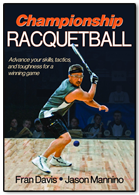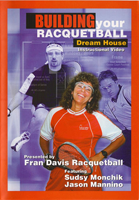
“Championship Racquetball
The art of court positioning is just as important in doubles as it is in singles. The downfall of most doubles teams is that the partners act as if they are playing singles and are very haphazard about where to go after the serve, after the return of serve, and during the rally. When you play doubles you want to be like a piece on a chessboard, knowing how to position yourself on the board as every move can cost you.
Getting into the right position for reaching a majority of the balls can win or lose a match. With four players on the court, you must be aware of everyone’s position at all times. You will need to move with necessary ebb and flow depending on where your opponents and partner are standing. You must move quickly to establish your proper place, which is determined by the shot that is hit and the position of your partner as well as where your opponents move.
Regardless of which core style you choose to use (as outlined below), make sure you and your partner are never within 5 feet of the sidewall – a cardinal sin in doubles. You want to leave the 5-foot lanes open for crosscourt, down the line, and wide-angle pass shots.
Let’s take a look at the Doubles Court Positions:
Core Court Positions: There are two core court positions you need to know when playing doubles: Side by Side and Front/Back. All variations stem from these two positions.
1-Side by Side: In the Side by Side formation, the court is divided in half vertically. One person plays the right side and the other person plays the left side. Both partners should hover around the dotted line and towards the back, staying even with one another.
2-Front/Back (I Formation): In the Front/Back formation, the court is divided in half horizontally. One person plays from the dotted line to the front wall, and the other person plays from the dotted line to the back wall.
Intermediate and Advanced Court Positions: Once you learn Side by Side and Front/Back court positioning, you are ready to move up to the intermediate and advanced positions, which are combinations or variations of the two core formations. As you improve as a doubles player, you will learn that you do not play just one type of court position; rather, you are always mixing and matching, moving and dancing, ready to cover anything your partner cannot get to.
1-Two-Thirds Side by Side: This is the same as Side by Side, but instead of dividing the court in half, you divide the court two-thirds to one-third.
2- L Formation: The court is divided into an L, and the stronger player covers the L on the court. This is designed for a strong and weak player that wants to play one level up, but the weaker player is not proficient at shooting balls off the back wall or hitting good ceiling balls.
3- Modified Side-by-Side, or S Formation: This is the court position most widely used by the pros and top amateur players. It is a true combination of the side-by-side and front/back positions, allowing players to maneuver around the court and make adjustments when necessary based on where the shooter is and what her tendencies are.
Use the Playing Doubles chapter in my book, Championship Racquetball to understand doubles court positioning in detail. This will lead to putting more pressure on the doubles team you are playing, Chapter 11 (pages 268-272).
I use “The Art of Doubles Court Positions” with my Championship Team, Rocky, Paola, Jason, Taylor, Sharon, Connor, Jordan, and Wayne, as at one point or another they all play or have played doubles. I encourage each and every one of them to use solid doubles court positioning to play at the highest levels of play. Here are some of the BEST doubles teams ever to play together. They’ve won numerous Amateur, Pro National, and World Championship titles with the above doubles court positioning:
Jason Mannino/Sudsy Munchik, Jason Mannino/Cliff Swain, Jason Mannino/Kane Waselenchik
Rocky Carson/Jack Huzcek, Rocky Carson/Jose Rojas
Paola Longoria/Samantha Salas
Connor Laffey/Wayne Antone
Jordan Cooperrider/Ericka Manilla
Let’s examine what tools Rocky, Paola, Jason and all of my athletes use for developing “The Art of Doubles Court Positions” by taking a closer look at all 3 sides of The Sports Racquetball Triangle: Conditioning, Mental, and Physical Skills
Left Side of the Triangle
Speed can be defined as getting from point A to point B as quickly as possible. Almost every athlete involved in a sport that requires running would love to move faster and more efficiently. Speed in racquetball, especially doubles, is imperative but unique because of the nature of the court itself. You must negotiate a 20 by 40 foot room while watching your opponent(s), the ball, and the wall.
The techniques and skills of racquetball require five different speed motions:
1. Starting speed helps you attain the highest rate of speed as quickly as possible so you can get into good center-court position or improve your return of serve.
2. Foot speed is needed to negotiate balls that are hit at different angles and come off the wall at different angles, speeds, and trajectories.
3. Hip speed (or rotation) is often necessary to turn and run as well as to generate more power, which we outline in chapters 1 and 2 of Championship Racquetball.
4. Backpedal speed is needed to relocate into good center-court position after the serve, or move to the back from center court to hit a ceiling ball, or move from the front to center court after you retrieve a great pinch or kill shot.
5. Change-of-direction speed is an often overlooked element of movement skills, but it is the most important in racquetball. There are four types of change of direction speed that we’ll work on: side-to-side, forward and backward, turning and running, and jumping.
Use the Conditioning and Flexibility chapter in my book, Championship Racquetball, to understand speed and what drills you can do to get faster. This will lead to more consistency, as you will be able to get to the balls faster and therefore shoot a better shot to put pressure on the doubles team you are playing, Chapter 10 (pages 238-243).
You want to make sure you are eating right and drinking lots of water as your body and mind NEEDS this in order to perform at it’s best, especially when you are playing doubles where rallies can be notoriously longer.
***Check my book, Championship Racquetball, for specific information on your NUTRITIONAL needs.
Right Side of the Triangle
Mental Skills
Communication is the key in any relationship, and doubles is just another relationship. You must be able to talk to each other and share your thoughts about the court position you are going to play during the match. There needs to be a quarterback, or leader, on the court calling the plays and watching your court position as well as your opponent’s court position. It’s then important to assess what is happening during the match and to make adjustments, if necessary. Also, after the match evaluate the good, the bad, and the adjustments needed.
Use the mental skills in my book, Championship Racquetball, to understand how important it is to communicate when you are playing doubles. Being on the same page with the same goals is the key to playing the best doubles possible.
Base of the Triangle
Physical Skills
Partner Reaction Drill …This is a timing drill that partners can do to sharpen their swords. Cliff (lefty) and Jason (righty) always did this before they played. They simply stayed at the dotted line, Cliff on the left and Jason on the right, and hammered the ball back and forth at each other in order to get used to the pace using kill and pinch shots. If it is done with 2 righties, Rocky and Jose, they BOTH practice this drill from both sides. This would make their hands, feet, and brains quicker at game time.
Make sure to track your progress by choosing how many good ones out of that total number you did. As you “learn the art of doubles positioning” and practice more and more of the specific doubles drills you will get more and more consistent with YOUR PARTNER.
Use the physical skills in my book, Championship Racquetball to understand the “Doubles Drills”, Chapter 11 (page 273-274).
ALL of the players I coach, from the professionals led by Rocky and Paola to the amateurs, know just how important it is to learn “The Art of Doubles Court Positioning.” It starts with understanding doubles formations when picking a doubles partner. My pro players doubles records speak for themselves…Rocky and Paola are BOTH the 2014 National Doubles Champions for their respective countries. They will BOTH be competing at the World Championships in Toronto, Canada this summer where Paola will be defending her doubles as well as singles titles.
In the next issue, I will continue to build your Championship Racquetball Game one level at a time so you too can be ready to become the champion you always dreamed of becoming, by giving you the tools to make it a reality. Rocky’s and all my athletes “Championship Racquetball Games” stem from their focus on ALL 3 sides of the triangle working together so they can develop into top competitors. Without a shadow of a doubt, they KNOW just how important it is to do the work. They are living proof it works and their titles substantiate it.
For details on more personalized instruction, a weekend camp, instructional DVD’s, our book, Championship Racquetball, and our APP (coming soon), ALL which covers all aspects of the Sports Racquetball Triangle and more, please visit www.FranDavisRacquetball.com.Fran Davis is a 2004 racquetball Hall of Fame inductee, Racquetball Woman of the Year 2009, Coach #2 IRT Pro Player and 1X US Open Champion, Rocky Carson; Coach #1 Women’s LPRT Pro Player and 4X and present US Open Champion, Paola Longoria; Coach Jr. World & National Champion, Intercollegiate Champion, & IRT Pro Player, Taylor Knoth; Coach Intercollegiate Champion & LPRT Pro Player, Sharon Jackson; Master Professional Instructor/Coach USAR-IP. International Racquetball Tour.










